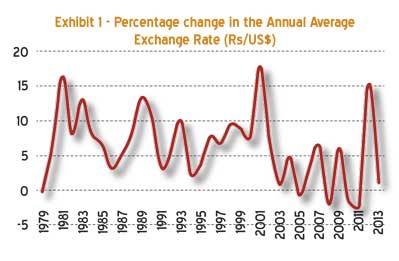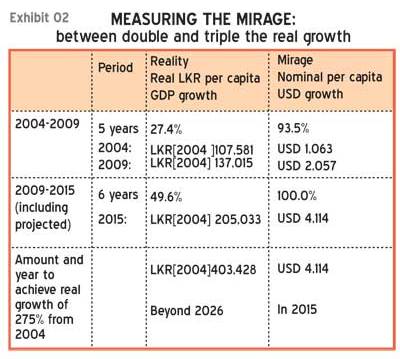By Verite Research–
-
Explaining the mirage of GDP growth optimism
Optimism about Sri Lanka’s future growth abounded at the Ceylon Chamber of Commerce’s economic summit held last week. The running refrain was that Sri Lanka doubled its gross domestic product (GDP) per person between 2004 and 2009, will repeat that success by 2015 and from there go on achieve a US $ 7,000 GDP per person by 2020.
These statistics are impressive and create an impression of tremendous growth. But they are also misleading. Understanding two important economic terms can help to expose the mirage and enable analysis of what’s really happening in the economy.
Difference between nominal and real
When economists report growth, they make a distinction between nominal and real growth. Nominal GDP growth is the total counted increase in the value of goods and services produced in Sri Lanka at current prices. But this means an economy can register GDP growth for two reasons. First, an actual increase in the value of goods and services produced. Second, because the prices of goods and services rise.
Clearly, it is important to distinguish between these two reasons. That is where the nominal and real distinction comes into play. Nominal growth measures the combination of increased production and increased price. Real growth, by contrast, only measures the increase in production.
A mirage is an illusion that makes a traveller believe that a desired goal is much closer than it is. Quadrupling per capita GDP from what it was in 2004 is desirable. But the claim that this will be achieved by 2015 is a mirage
The distinction is important because only real growth measures the actual improvement in economic conditions. Nominal growth without real growth is no growth at all – it just means that prices went up. GDP growth rates reported for countries are always reported in real terms. But using a sleight of hand switch to US dollar terms, the media and policy discourse in Sri Lanka are routinely reporting a mostly nominal growth measure as if it were a real measure of growth.
Government economists calculate a number called the GDP deflator, which estimates the increase in prices of all goods and services produced in the economy. The deflator’s size is the difference between nominal and real GDP growth — therefore the larger the deflator, the larger the difference between nominal and real growth. The GDP deflator is like a measure of inflation, except that inflation averages the price increase of a typical consumption basket, whereas the deflator averages the price increase of everything produced in an economy.
Mirage of GDP growth conceals three harsh realities
First, it conceals that real GDP growth in Sri Lankan rupees per capita is as low as one third to half the growth advertised in US dollars. For those consuming in Sri Lanka, it is the real growth in rupee terms that is relevant – pricing and purchasing in Sri Lanka is not done in US dollars.
Second, it conceals that the nominal US dollar has been reducing in buying power. That is, like any other currency, the US dollar also depreciates in real value due to inflation.
Third, it conceals that these US dollar-based growth claims are highly fragile. They can change in an instant with a change in the exchange rate between the rupee and the US dollar and Sri Lanka policymakers have a long history of making regular surprise downward adjustments to its currency. (See Exhibit 1)

2004 to 2009 GDP growth did not double. It increased about 25 percent.
In 2010, it was widely touted that in the five years between 2004 and 2009 Sri Lanka’s per capita GDP doubled. In US dollar terms, it almost did, increasing by 93.5 percent. (See Exhibit 2) But in real rupee terms, GDP growth did not even remotely approach a doubling. The precise increase was 27.4 percent (less than one third of the USD-denominated presentation).
2009 to 2015 GDP growth will not double either: it will increase at most 50 percent
The present projection of hitting US $ 4,000 by 2015 implies yet another doubling from 2009. Indeed, if the exchange rate is kept fixed, on current projections, per capita GDP would have doubled from 2009 to 2015. But this is equally a mirage. Projecting forward for 2014 and 2015 even with a very positive outlook (7.5 percent real growth and a GDP deflator of 6 percent) real per capita GDP growth will increase by only half of the USD-denominated figure.
Growth promise made for 2015 will only be achieved after 2026
In 2004, the GDP per capita and the exchange rate (101.19 to a dollar) the per capita GDP was 1,063. The promise of reaching US $ 4,000 dollars by 2015 implies a quadrupling (a factor of 3.75 to be precise) in per capita GDP over the period. But even on the very optimistic economic projections used here, the real GDP per capital will increase by that quantum – a multiple of 3.75 on 2004 – only after 2026. (See Exhibit 2)

A previous Verité Insight titled ‘Can Singapore Chinthanaya work for Sri Lanka’ pointed this out but it was poorly drafted, giving the mistaken impression that the US $ 4,000 per capita target would not be achieved till 2026. Verité apologises for that impression. Real growth in Sri Lanka cannot be meaningfully measured in dollar terms because it confuses a nominal measure with a real measure. The claim made by dollar-denominated advertisement is that per capita GDP will almost quadruple by 2015 from what it was in 2004. But as this insight has explained more carefully, in real terms this projected increase will not be achieved till after 2026 – even on very optimistic economic projections.
GDP growth rates reported for countries are always reported in real terms. But using a sleight of hand switch to US dollar terms, the media and policy discourse in Sri Lanka are routinely reporting a mostly nominal growth measure as if it were a real measure of growth
A mirage is an illusion that makes a traveller believe that a desired goal is much closer than it is. Quadrupling per capita GDP from what it was in 2004 is desirable. But the claim that this will be achieved by 2015 is a mirage.
(Verité Research provides strategic analysis and advice for governments and the private sector in Asia. Comments welcome, email [email protected])
Courtesy – Daily Mirror
